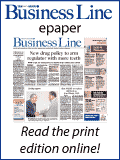Business Daily from THE HINDU group of publications
Monday, Sep 18, 2006
ePaper
Business Daily from THE HINDU group of publications Monday, Sep 18, 2006 ePaper |
|
|
| |
|
|
|
eWorld
- Interview Info-Tech - Outsourcing Made to order Paromita Pain
It is a discipline that uses a structured methodology to design the interface of a product, with the goal of making the product fit the needs of users. The end result is an easy-to-use product.
 A World War II concept, Usability Engineering, is opening new vistas in the Outsourced Product Development (OPD) space. eWorld catches up with Jhumkee Iyengar, Head, Usability Engineering and Samir Chabukswar, Technical Manager - Usability Engineering, of Persistent Systems, for more on this idea that actually developed from plane crashes. Excerpts: How new is the concept in India? A nascent idea in India, Usability Engineering is a relatively young profession in the US and Europe. It is a discipline that uses a structured methodology to design the interface of a product, so it can fit the needs of users. Though the term `usability' is often used analogous to `software usability,' it can also be applied to physical products and systems and is referred to in physical ergonomics, human factors engineering or human computer interaction. Since the whole product is designed and developed offshore in the OPD space, it makes business sense to vertically integrate all component functions needed to design and develop software. Usability, being a very important aspect of design, fits well under this philosophy. How does Usability Engineering work? The basis of a usability engineer's work is the user's goals and has a broad framework of User-focused analysis: We first understand and define user tasks and goals through user interactions and observations. User-focused design: Then the design is created to include these defined user criteria. Usability testing: We test the design repeatedly using actual users and keep improving the design until it meets the defined criteria for ease of use. Usability Testing is typically conducted in a `Usability Laboratory' where users are tested using techniques of cognitive and experimental psychology. The objective is to investigate problem areas and revise the design to make it `usable' by average (non-technical) users.

Why is the concept receiving attention now? The idea first originated during World War II when a large number of planes were crashing, with the crashes loosely being attributed to `human error'. Thereafter psychologists got involved and identified the real reasons as a lack of knowledge about `human capabilities' and `human limitations'. The field of Human Factors Engineering subsequently evolved. The mission of this field is to make products and technology easy and transparent to use. There is so much attention on Usability Engineering now because organisations are living the costs and pains of not incorporating the `human element' into the product design equation. The realisation that incorporating it results in better, faster and higher quality end products, that work not just in terms of technology but also for the people who use them, is driving the field today. What has led Persistent Systems to add it to its PDLC (product development lifecycle) portfolio? At Persistent, we use Usability Engineering as a differentiator for today's software. The initiative was launched about a year ago. Usability here also adds to the advantage of a `total solution' to customers. It comprises a six-member multidisciplinary team at present. Many of our team members have formal education and training in Human Factors Engineering from US universities. They also have skills in Prototype design and Graphic design. We recently set up a Usability Engineering laboratory, which we believe is one of a kind, in Pune, and among the very few in India. Changes aren't just proposed — we are also part of the implementation to ensure that a usable design rolls out with flexible offerings that work with any PDLC process at any stage. How do you measure the benefits of usability engineering? We compute the Return on Investment (ROI) in Usability Engineering as a part of our routine practice. It is usually computed as productivity improvement or reduced customer support calls or shortened training time, among others. All of these are easily translated into money saved by the company. Typically, ROI on Usability Engineering is very high and astounding for clients when they finally compare the money invested and the money saved. UE is in its infancy in India. But we have the potential to evolve into a serious partner for global Usability Engineering work. Indians have a unique advantage of being analytical, creative and effective communicators — important capabilities needed for this space. However this will only be realised if industry and academia together pay attention to building the discipline and expertise, as none exists today. There is no university in India that offers a program in Human Factors Engineering. A majority of practitioners are self-taught and often practice ad hoc usability. Curriculum in this field is non-existent, like the expertise to teach it. What is the demand for Usability Engineering? The demand exists, but the concept needs to be intelligently sold. India is still being viewed as a `back end' destination that competes on price first rather than high expertise. A manpower projection in 2002 by Jakob Nielsen says, "India will need to train 400,000 usability professionals in the next six years to meet its own projections."
More Stories on : Interview | Outsourcing
Article E-Mail :: Comment :: Syndication :: Printer Friendly Page
|
Stories in
this Section |

|
|
The Hindu Group: Home | About Us | Copyright | Archives | Contacts | Subscription Group Sites: The Hindu | The Hindu ePaper | Business Line | Business Line ePaper | Sportstar | Frontline | The Hindu eBooks | The Hindu Images | Home | Copyright © 2006, The Hindu Business Line.
Republication or redissemination of the contents of this screen are
expressly prohibited without the written consent of The Hindu Business
Line
|